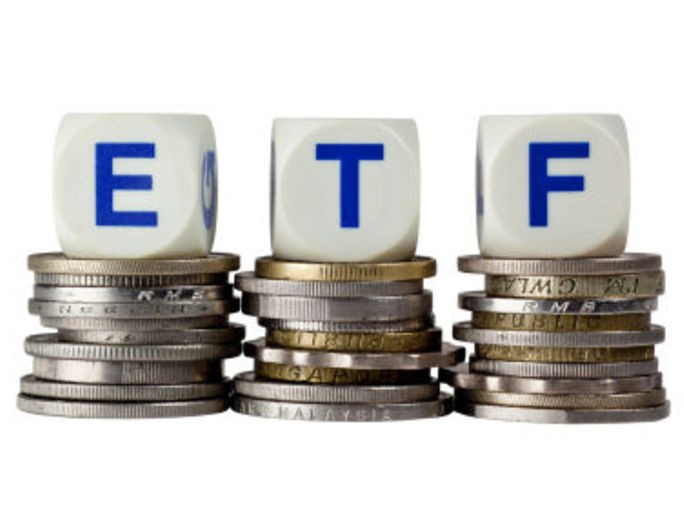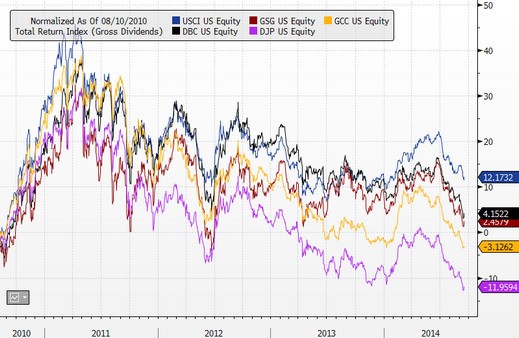Complete Guide To Commodity ETF Investing Ten Commodity ETFs Every Investor Should Know
Post on: 9 Июль, 2015 No Comment

Commodities are the new black in the world of investing, thanks in no small part to the rise of ETFs as the tool of choice in more and more portfolios. Commodity ETFs saw cash inflows of more than $30 billion in 2009, as total assets more than doubled on the year. According to the ETF screener. there are currently 91 exchange-traded commodity products, including inverse and leveraged funds. At the end of 2009, there was $73.7 billion in these funds, but most of these assets were concentrated in a handful of tickers. GLD alone accounted for more than half of commodity assets, and the top seven commodity funds (SLV. DBC. UNG. IAU. DBA. and DJP ) made up almost 85% of the total amount.
But theres a lot more to the world of commodity ETFs than these mega-funds. Below are profiles of ten commodity ETFs that arent even on the radar screens of most investors, but which present compelling investment theses and offer potential for unique exposure.
10. ELEMENTS S&P CTI ETN (LSC )
Most commodity products fall neatly into either a long or short bucket, but LSC is a horse of a different color. The index to which this ETN is linked applies a long/short strategy to six commodity sectors comprised of sixteen traditional, physical commodity futures contracts. The individual commodities are grouped into six sectors (energy. grains. industrial metals, precious metals, livestock. and softs ) and each sector, except the energy sector and softs sector, is represented on either a ‘‘long’’ or ‘‘short’’ basis, depending on recent price trends of that sector.
The energy sector is represented on either a ‘‘long’’ or ‘‘flat’’ basis (protecting against the potential for a big loss from a short position if crude prices surge), and each commodity within the softs sector (cocoa, coffee. sugar. and cotton ) is represented on either a ‘‘long’’ or short’’ basis separately rather than in the aggregate as a single sector.
The position of each sector is determined by comparing the current sector price to a moving exponential average, meaning that LSC essentially applies a momentum investment strategy to commodities. So in addition to protection to inflation and a diversifying agent, investors can access a strategy long popular with hedge funds and commodity traders.
9. PowerShares DB Base Metals Double Long ETN (BDD )
Over the last twelve months, only two commodity ETFs have gained at least 100%: the iPath Copper ETN (JJC ) and this base metals fund from PowerShares DB. The index underlying this ETF is equally-weighted between aluminum, zinc, and copper. offering leveraged exposure to three resources widely used in manufacturing operations.
As its name suggests, BDD is indeed a leveraged product, but not in the sense that most investors imagine. Instead of the daily exposure offered by products from Direxion and ProShares. BDD resets on a monthly basis, meaning that volatile markets are less likely to erode returns.
8. United States 12 Month Natural Gas Fund (UNL )
Investing in natural gas was one of the major trends of 2009, as evidenced by the more than $5.5 billion that flowed into the United States Natural Gas Fund (UNG) during the year. But as many investors learned the hard way. funds that invest primarily in near-month futures contracts can deliver undesirable results when markets are consistently contangoed.
Similar to UNG, UNL is designed to track changes, in percentage terms, of the spot price of natural gas delivered at the Henry Hub, Louisiana. But theres a key difference between these funds: UNLs holdings consist of near month contracts and contracts for the following 11 months, meaning that only a fraction of assets are rolled each month. UNL may be less responsive to changes in spot prices of natural gas, but it will also generally have a far lower roll yield when the futures curve slopes upward.
Despite this potential advantage, UNL has been slow to catch on: the fund has less than $40 million in assets, compared to more than $4 billion for UNG.
7. UBS E-TRACS DJ-UBS Commodity Index Total Return (DJCI )
Commodity ETFs can bring valuable diversification benefits to traditional stock-and-bond portfolios, but one of the potential drawbacks of these products is the costs they incur (especially relative to the sub-ten basis point expense ratios offered by some ETFs). DJCI charges just 0.50%, making it the cheapest way to gain broad commodity exposure.
Of the ten exchange-traded products offering long exposure to a diversified basket of commodities (see the complete list here ), DJCI features the lowest expense ratio by a wide margin. The iPath Dow Jones-UBS Commodity Index Total Return ETN (DJP) tracks the exact same index as DJCI, but charges an extra 25 basis points. DJP has more than $2 billion in assets thanks in large part to its first mover advantage, but DJCI is far more efficient from a cost perspective.
6. ETFS Physical Swiss Gold Shares (SGOL )
Most investors looking to gain exposure to gold prices through ETFs settle on the SPDR Gold Trust (GLD) unaware that a similar product from ETF Securities offers identical exposure at a lower cost. In addition to the almost negligible cost gap (0.39% vs. 0.40%), this fund sets itself apart from GLD by offering geographic diversification. SGOL stores its gold bars in secure vaults in Switzerland. A repeat of the gold confiscation of 1933 is unlikely, but for those investors overcome with paranoia (many gold bugs are), this peace of mind might be worth the lack of additional cost.
By size and trading volume, SGOL pales in comparison to the gold SPDR. But with assets of more than $300 million and average daily volume of more than 150,000 shares, SGOL offers plenty of liquidity for almost any investor.
5. GreenHaven Continuous Commodity Index (GCC )
This ETF uses futures contracts to track the Continuous Commodity Index-Total Return, an equal-weighted benchmark of 17 individual commodities plus a Treasury Bill yield. Because this benchmark is equal-weighted, GCC offers greater exposure to grains, livestock, and softs than most other diversified commodity products (and lower exposure to energy commodities).
Two additional interesting twists of GCC: 1) the fund is rebalanced daily to ensure that allocations for each commodity remain as close to 1/17th as possible, and 2) the commodities underlying the index are averaged across the futures curve six months out, minimizing the potential for a costly roll process each month (anyone invested in UNG knows how valuable this can be).
4. iPath Dow Jones-UBS Sugar Subindex Total Return ETN (SGG )
One of the primary benefits of adding commodities to a portfolio is the low correlation between this asset class and stocks and bonds. According to the iPath web site, the issuers diversified commodity ETN has a correlation with with S&P 500 of 0.25. The relationship between equity markets and resources used heavily in manufacturing operations: the correlations for copper (JJC ) and energy (JJE ) are 0.43 and 0.28, respectively. Sugar, however, exhibits a near perfect lack of correlation with both stocks and bonds: correlation between this ETN and the S&P 500 is just 0.03. Correlation between SGG and the Barclays U.S. Aggregate Bond Index is -0.01.

SGG is also an interesting option for more active traders because of its tremendous volatility. in 2009 this ETN gained or lost 100 basis points in 65% of trading sessions, and moved by at least 3% in one day out of every five.
3. IndexIQ ARB Global Resources ETF (GRES )
This fund isnt technically a commodity product (it invests primarily in stocks), but offers a way for investors to gain indirect exposure to prices of natural resources without dealing with the complexities and potential drawbacks of a futures-based strategy. GRES tracks an index that uses momentum and valuation factors to identify companies that operate in commodity-specific market segments and whose equities trade in developed markets.
There are a number of funds that invest in equities of commodity-intensive companies (GDX and HAP are two of the more popular), but GRES is different from these funds in one key respect: this fund includes short exposure to global equities (through positions in S&P 500 and MSCI EAFE Index futures) as a partial equity market hedge.
2. ETFS Physical Palladium Shares (PALL )
PALL is less than a month old, but the first U.S.-listed palladium ETF is already a major success. taking in more than $150 million in assets since its launch. Palladium is one of the worlds rarest metals, and offers a unique blend between a safe haven investment and a play on the industrial sector.
Palladium is a precious metal that is far more scarce than either gold or silver. It is also used by automakers about half of the global demand for palladium comes from the automotive industry for use in catalytic converters. As such, PALL can be used to play multiple global trends. Demand for this metal is tied to the health of the auto industry (theres not an ETF for that yet) and could be impacted by future climate change regulations and initiatives.
1. United States Commodity Index Fund (TBD)
The last fund on our list doesnt existyet. United States Commodity Funds has filed for approval with the SEC for the first active commodity ETF. The fund, which would be based on the actively-managed SummerHaven Dynamic Commodity Index, will choose 14 commodities each month from a universe of 27 possible resources.
The index is constructed based on research showing that a hypothetical portfolio composed only of commodities trading in backwardation would have outperformed broader baskets of commodities, as well as portfolios of those trading in contango, by a substantial margin. Momentum investing is a popular strategy for commodity investors, and it may soon make its way into an ETF (see a better writeup of this new fund here ). See Seven Most Anticipated New ETFs of 2010 for a complete look at the product pipeline.
For updates on the launch of this fund (and news on all new ETF launches), sign up for our free ETF newsletter .
Disclosure: No positions at time of writing.














